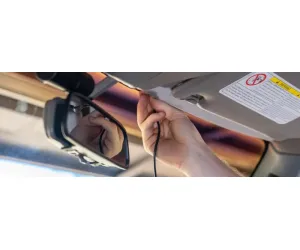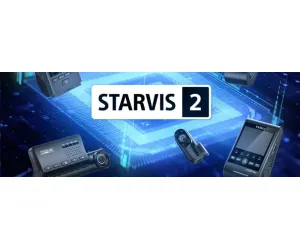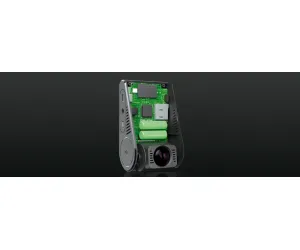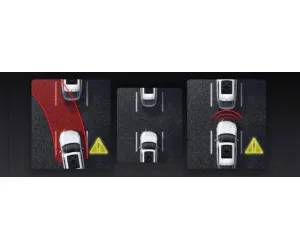
When shopping for a dash cam, resolution specs like 1080p, 2K, or 4K often catch the eye. But the real key to video quality—especially in low light or high-speed conditions—is the image sensor. It’s the component that determines how clearly your dash cam captures what matters.
In this expert guide from BSTA.sa, we cover:
- What image sensors are and how they work
- A short history of dash cam sensor development
- The best dash cam sensors in 2025
- How to compare sensor specs
- A side-by-side comparison of common sensor types
- Which sensors are used in VIOFO dash cams
- FAQs to help you choose the right device
A Brief History of Dash Cam Image Sensors
In the early 2010s, dash cams used basic VGA or 720p sensors, with poor low-light performance and blurry results. The breakthrough came with Sony’s first-generation STARVIS sensors around 2014, designed for enhanced sensitivity in darkness.
By 2023, Sony introduced STARVIS 2, a next-generation series offering:
- Better night vision
- Improved motion clarity
- Superior HDR for visibility in shadows and bright areas
Today, Sony STARVIS 2 sensors like IMX678 and IMX675 are used in the most advanced dash cams available.
What Is a Dash Cam Image Sensor?
An image sensor is a chip inside the dash cam that converts light into digital information. It governs:
- Video sharpness and resolution
- Performance at night or in poor lighting
- Dynamic range and contrast
- Frame rate (smoothness)
- Noise levels in low-light scenes
Even a 4K dash cam will underperform if it uses a cheap or outdated image sensor.
Sensor vs. Resolution: What Matters More?
Many shoppers assume 4K always means better quality. But this isn’t true if the sensor is low-grade. For example, a 2K dash cam with a Sony STARVIS 2 sensor often outperforms budget 4K models—especially at night.
Key takeaway: Resolution is helpful, but sensor quality determines real-world performance.
Top Dash Cam Image Sensors in 2025
1. Sony STARVIS 2 (IMX678, IMX675)
- Performance: Premium
- Benefits: Exceptional clarity, excellent night vision, 4K/2K HDR support
- Used In: VIOFO A329S, A229 Pro, A329T
- Best For: Pro drivers, rideshare, highway surveillance
2. Sony STARVIS (IMX335, IMX307, IMX291)
- Performance: Mid-range
- Benefits: Good 2K/Full HD clarity, reliable for day and night
- Used In: VIOFO A129 Pro, A229 Plus (interior), Vantrue S1
- Best For: Everyday commuting and general use
3. OmniVision CMOS Sensors
- Performance: Entry-level
- Benefits: Affordable, energy efficient
- Limitations: Poor low-light visibility, basic HDR
- Best For: Budget-conscious, daylight-only driving
How to Compare Image Sensor Specs
When comparing dash cams, check these sensor-related specifications:
- Sensor Size: Larger sensors (e.g., 1/1.8") collect more light = clearer video.
- Pixel Size: Bigger pixels (e.g., 2.0µm) reduce noise in night scenes.
- Frame Rate: 60FPS = smoother playback and better clarity during motion.
- High Dynamic Range (HDR): Balances shadows and highlights for plate visibility.
Comparison: Most Common Dash Cam Image Sensors in 2025
Choosing the right image sensor is crucial—especially for plate capture, night vision, and balanced HDR recording. Here's a side-by-side comparison:
| Feature | Sony STARVIS 2 (IMX678 / IMX675) | Sony STARVIS (IMX335 / IMX307) | OmniVision (e.g., OV4689) |
|---|---|---|---|
| Launch Year | 2023–2024 | 2017–2019 | Varies |
| Technology Generation | STARVIS 2 | Original STARVIS | CMOS |
| Max Resolution | 4K (IMX678), 2K (IMX675) | 2K–2.5K | 1080p–2K |
| Sensor Size | 1/1.8” (IMX678), 1/2.8” (IMX675) | 1/2.8” | 1/3” or smaller |
| Pixel Size | 2.0µm | 1.45µm–1.85µm | Often <1.5µm |
| Low-Light Performance | Excellent | Very Good | Poor to Average |
| Dynamic Range (HDR) | Enhanced HDR | Standard HDR | Basic |
| Noise Reduction | Advanced AI-based | Standard | Basic |
| Motion Clarity | Smooth 60FPS | Good 30–60FPS | Often 30FPS only |
| Infrared Support | Yes (IMX675 cabin cam) | Yes (select models) | Limited |
| Power Consumption | Efficient | Efficient | Very efficient |
| Used In Dash Cams | VIOFO A329S, A329T | VIOFO A229 Plus, Vantrue S1 | Entry-level dash cams |
| Best For | Pro drivers, nighttime detail | City driving, general use | Basic daytime recording |
Which Sensor Is Right for You?
| Driving Use | Recommended Sensor | Example Model (on BSTA.sa) |
|---|---|---|
| Night driving / security | Sony STARVIS 2 | VIOFO A329S, A229 Pro, A229 Plus |
| Interior monitoring | Sony STARVIS 2 IMX675 | VIOFO A329S 3CH, A229 PRO 3CH, A229 Plus 3CH |
| City commuting | Sony STARVIS IMX335/307 | VIOFO A129 Pro |
| Budget or daytime only use | OmniVision CMOS | Entry-level dash cams |
Image Sensors Used in VIOFO Dash Cams
VIOFO uses Sony's top-performing sensors across its dash cam range. Below is a breakdown of their sensor configurations:
VIOFO A129 Pro Duo
- Front: Sony IMX317 (8MP) — 4K UHD
- Rear: Sony IMX291 (2MP) — Full HD
VIOFO A229 Plus
- Front & Rear: Sony STARVIS 2 IMX675 (5MP) — 2K HDR
- Interior (3CH): Sony IMX307 — Full HD with low-light support
VIOFO A229 Pro
- Front: Sony STARVIS 2 IMX678 (8MP) — 4K HDR
- Rear: Sony STARVIS 2 IMX675 (5MP) — 2K HDR
VIOFO A329S
- Front: Sony STARVIS 2 IMX678 (8MP) — 4K 60FPS
- Rear & Cabin: Sony STARVIS 2 IMX675 (5MP) — 2K HDR, IR for interior monitoring
These sensor setups give VIOFO cameras a performance edge in clarity, especially for night-time and multi-angle monitoring.
FAQs – Dash Cam Image Sensors
-
What is the best image sensor for dash cams in 2025?
STARVIS 2 IMX678 and IMX675 offer unmatched clarity, especially at night. -
Is 4K always better than 2K in dash cams?
Not always. A 2K cam with a high-quality sensor often outperforms a cheap 4K one. -
Why is my dash cam blurry at night?
Likely due to a weak image sensor. Upgrade to a model with STARVIS or STARVIS 2. -
What’s the difference between STARVIS and STARVIS 2?
STARVIS 2 features better HDR, motion handling, and low-light performance. -
Which VIOFO dash cams have STARVIS 2?
A329S, A229 Pro, and A229 Plus (front/rear) all use STARVIS 2 sensors. -
Are sensor size and pixel size important?
Yes. Bigger sensors and pixels improve night clarity and reduce noise. -
Is OmniVision a good sensor brand?
It’s okay for daylight use but lacks performance in night and HDR scenarios. -
Can I upgrade my dash cam’s image sensor?
No. The sensor is built-in. For better results, upgrade to a new dash cam. -
What else should I look for besides sensor?
Check for HDR support, frame rate (e.g., 60FPS), and wide dynamic range.
Final Thoughts
The image sensor is the foundation of dash cam performance. From capturing license plates at night to recording accidents with clarity, your sensor choice makes all the difference.
At BSTA.sa, we offer dash cams equipped with Sony STARVIS and STARVIS 2 sensors—carefully selected for drivers who demand reliability, detail, and safety on the road.
Browse our Dash Cam collection and enjoy expert support, fast shipping, and a local warranty across Saudi Arabia.







